How can you trade with the so-called winning “edge”? In this final installment of this 3-part series, we answer this question. In just six minutes, this step-by-simple-step procedure will give your trades the coveted trading edge.
Using the “RadioActive Profit Machine” technique, any trader can positively change the expectancy of their trades… putting the odds on their side… because of how the RadioActive Method works to skew every starting position in your favor.
You’ve already invested one of your six minutes. Here’s what to expect in the next five:
- The PROBLEM– why do most traders end up losing, even the smart ones?
- Why the PROBLEM persists– most people are looking for solutions in the wrong place
- What’s POSSIBLE– how to skew your trading odds using an unexpected technique
- What’s DIFFERENT NOW– how repeated iterations of the skewed trading structure performs
- What YOU SHOULD DO NOW– get more information on what savvy traders in 38 countries are doing
Read on, Trader. You’re the hero of this story:
What Gets in the Way of Trading Edge?
Every trader struggles with the “Martingale” effect which dooms most trading systems before they launch.
Kind of an “ANTI-edge”.
I’ve personified (mm, maybe monster-ified) the Martingale before in other posts in these series.
The Martingale’s sinister mission is to destroy your nest egg, dealing death by a thousand cuts.
Let’s look a stock whose signature implies that it could gain OR lose 10% in the next month.
Furthermore, let’s assume that it’s even chances: 50/50 either way.
Even though it seems that over a long enough time horizon everything will even out… it won’t.
This is because of our friend the Martingale.
Assume a $10,000 stake.
You lose… -10%.
Now what you have is $9,000.
But then you make +10%!
Ohhh… the +10% gain on the $9,000 is $900,
Meaning that you have just $9,900.
When you had started with $10,000.
Nuts.
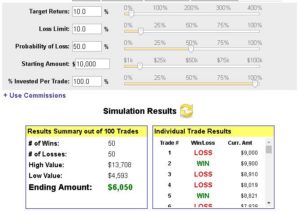
The ANTI- Trading Edge: You’d think you would be in the same place winning half the time and losing half the time. (click to embiggen)
The same thing happens if you win first:
$10,000 grows +10% to $11,000,
…but if the $11,000 takes a -10% hit, it’s back to $9,900 again.
Now, take that principle and repeat the process 100 times.
Hear the sickening sound of crunching bones? That’s your savings, dude.
We see the $10,000 balance dwindle to just $6,050 because fearsome power of the Martingale…
Why Can’t YOU the Get “Edge” Trading?
Many investors mistakenly thing that higher payouts will result in a better payday.
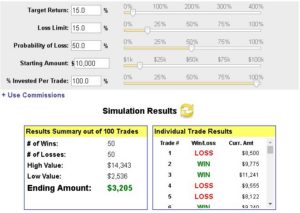
Shooting for higher returns means shooting yerself in the foot; 68% loss instead of 40%! (click to embiggen)
But think about it: higher returns ALWAYS come with higher risks.
What and if we choose stocks that could win or lose by 15% instead of 10%?
The Martingale strikes again.
Even probability, 50/50… coupled with even odds (1:1 risk/reward) will eventually bleed you dry.
Making the percent higher will only speed the process.
What MOST Traders Try to Get themselves Edge
We all like to be right.
In the last scenario we’ll get the EDGE all right; all we have to do is be right more often!
Say you learn a better way to read charts, or determine a company’s worth… and it makes you win 55% of the time instead of 50%:
At first blush, it seems that all you need to do is be right more often.
And it might seem to make sense at first. Really.
But let’s consider TWO big “IF’s”.
Number One: IF your bright new analysis just turns out to be luck, that 55% winning record might be pie in the sky.
Number Two: IF you are indeed right more often than you are wrong, you can still get caught by the Martingale!
Those slippery equations that we showed you in parts One and Two prove that being right more often won’t necessarily make you a winner.
Repeated iterations just make the problem worse while we’re trying to tweak our systems.
In fact, we like being right (or are afraid of being WRONG) so much that the Martingale sniffs out traders in denial… and ruins them by the bushelful.
So what’s the solution? If attempts to get a trading edge by better technical analysis, or fundamentals DON’T work, how can a trader win?
Hold on to your hat.
I’m going to make the unpopular assertion that you don’t need to be right more often to make it as a trader.
Trading “Edge”… without Being Right More Often?
Here’s the most common way that people try to skew their results in their favor:
They TRY to be RIGHT more often.
And it’s a lot harder to do than you might realize.
But I have news.
There’s a better way to skew your long-term results.
And it’s infinitely easier than burning the midnight oil looking for the best stock,
…or pulling your hair trying to make sense of trendlines and indicators.
Introducing the REDLine, one of three key principles of RadioActive Trading:
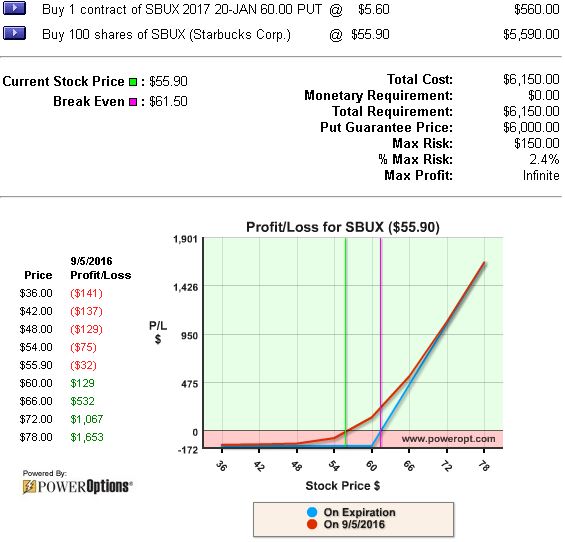
The “RadioActive Profit Machine” is assembled with 100 shares of stock to 1 In-the-Money, far away put option. The REDLine skews the trading expectancy so that losses stay low, but the upside is open
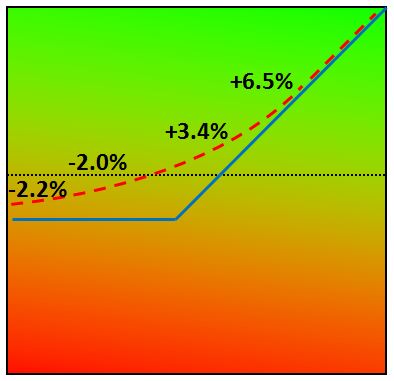
Same stock, different expectancy. The unique “RadioActive Profit Machine” structure SKEWS odds in your favor…
The question has been, “1. How can I be right more often?”
This question reflects the state of mind of probably 95% of the investing public.
The logical follow-on questions have been,
“2. How would my account be affected if I was right more often?”, and
“3. How difficult would it be to make that happen?”
But as we’ve seen already, your account doesn’t always do better just because you pick more winners.
And it isn’t easy to pick winners more often in the first place.
Here’s a switch for your paradigm…
We’ve been asking the wrong questions. Let’s try different ones:
“1. Is it necessary for me to be right more often to make more money?”
“2. How would my account be affected if I could skew my risk/reward so I don’t have to be right more often?”
“3. And perhaps most important… how easy would THAT be to make happen?”
Better questions get better answers.
How “Skew” Gives You the Trading Edge
Do you see how much easier it is to skew your results by losing less,
…instead of breaking your back trying to be right all the time?
It’s time to start
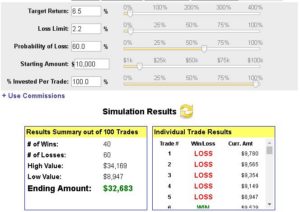
Trading Edge probability against. 15% +/- converts to 6.5% vs. 2.2%. Even if you were losing most of the time, you’d still do well!
looking at your trading a new way.
Rather than trying to be a control freak, trying to BE right… instead, let’s TRADE right.
By using a structure that keeps possible losses to single digits, we change the odds.
Before, trading a stock that could go 10% up and 10% down, and trying to be right more often didn’t perform great, even if you could guarantee that you’d be right more often.
NOW, even if you LOSE more often than win, trading “edge” covers you.
But that’s not all.
The unique structure of the RadioActive Profit Machine… a “married put” trade that breaks all the traditional rules around how a married put trade is supposed to be assembled… can make it possible for you to hit some serious home runs.
Kicking Trade BUTT With Your Trading Edge
Now today’s examples were more or less easy to follow. A stock goes up ten, fifteen… a stock goes down ten, fifteen.
But every once in a while the market takes a total DUMP…
…and also, sometimes the trading muse smiles on you.
😎
Here’s the point of structuring your trades with the REDLine principle and the RadioActive Profit Machine:
RadioActive Trader Mike Chupka had one stock, Silver-Wheaton (SLW) totally blow its doors. Nice job picking SLW Mike.
BUT… in the same twelve month period another of Mike’s picks, Talisman Energy (TLM) absolutely went in the toilet. The stock went down by more than 50%. Yikes.
So Mike’s 65%+ WIN would normally be eclipsed by his loss.
Think about it: a 50% loss takes a 100% win to recover… double your money after losing half of it, and you’re right where you started.
So Mike… though he picked a 65%+ winner… would have been KILLED by the 50% loser!
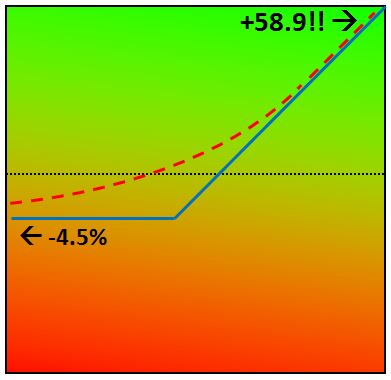
The POWER of Skew (not to scale). No matter how low his stock goes, Mike is protected to single digit percents. 4.5% is this most he lost. But the sky’s the limit when he catches a winner!
But not so fast: Mike was using the RadioActive Profit Machine setup.
So no matter what what happened, he wouldn’t risk more than single digit percents.
His 50%+ loser only *actually* lost him 4.5%.
(4.5%… the most he ever lost in that 12 month period… boo-hoo Mike)
And his 65%+ winner didn’t win 65%… the expense of the put took away from that a little teeny bit…
…so he “only” made 58.9%.
That’s on 300 shares of stock and 3 put options, a capital investment of $6,450.
There’s no theoretical limit on how much a stock that’s protected this way might gain.
But there is a tight, single-digit limit on how much you can possibly lose.
SO, skewed expectancy… how do ya like me now?
I WANT the “Edge”… So What Should I do NOW?
So, dear Reader! Let me challenge you to think about what “skew” means to you and your account… now that you know the one factor that’s more important than any other: controlling losses.
Think about YOUR trading record in the last twelve months.
If you had tightly controlled your losses to be only 2-5% all year… but allowed your winning stocks the ability to ride higher,
…would you be in a better position today than you are now?
😉
If you’re even considering how much better your total account might do, if you never lost more than single digit percents,
…you NEED to get this full report.
Here’s what we’re offering for a limited time, as well as what it’ll take for you to get it:
- A premium PDF with all three posts, plus exclusive content
- An invitation to a free webinar, only for select Readers of this blog this week
- All your questions answered about how to get the trading EDGE using the RPM setup
To get your premium PDF with Expectancy, Position Sizing, and How to Skew Expectancy, plus a webinar and exclusive content, just do this:
- Post a question or feedback in the Comments section and
- Share this post on one or more of your social channels.
The social shares are on the honor system. There are buttons above and below, and if your social channel isn’t represented let me know and I’ll put it in for you.
When you post in the Comments section, YOUR EMAIL IS NOT MADE PUBLIC. We respect your privacy and you will not receive any third-party offers. I’ll use the email to send your exclusive content and webinar invitation only.
Okay Traders! Looking forward to sending you some valuable stuff.
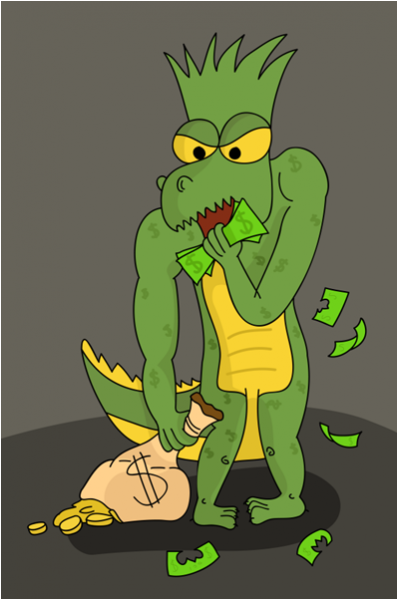
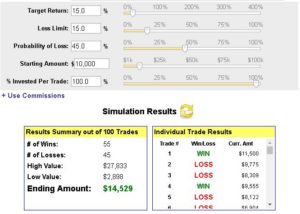
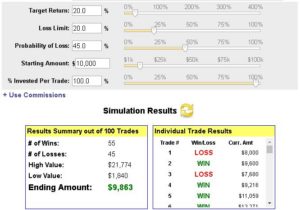
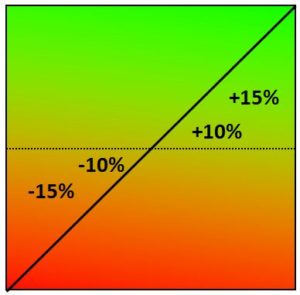
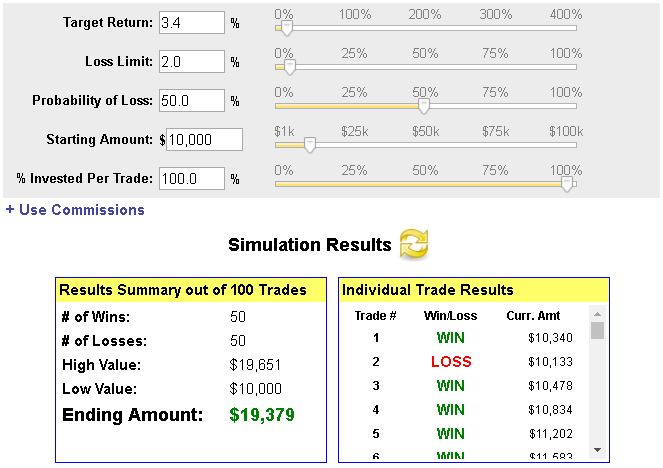
 I'm Kurt Frankenberg, and I have discovered how to truly put the odds on the side on the individual investor.
I'm Kurt Frankenberg, and I have discovered how to truly put the odds on the side on the individual investor.
Hi Kurt, it’s Jay again. I always read your stuff and your blog with bated breath (don’t worry.. i always brush and floss and gargle) and this 3 part series is no different. It’s awesome and keep up the good work. I never stop learning from you.
Awwwww shucks… thanks Jay!
If you have any questions now’s the time. I’m consolidating these three parts, PLUS adding some bonus material. The questions are the basis of most of the bonus stuff, so lay ’em on me.
Look for the finished PDF next Wednesday. Til then,
Happy Trading!
Kurt
Jay, if you didn’t grab your copy yet of the PDF, visit
http://blog.radioactivetrading.com/expectancy-positionsizing-skew/
Happy Trading!
Kurt
Please explain Redline theory. I am subscriber to poweroptions
Thank you.
Gladly Harvey! I’ll give a quick answer here, and a more detailed treatment on the subject in the PDF I promised. Give me a few days to compile questions and answers (which I’ll add to the PDF) and you’ll see it in your mailbox next Wednesday.
So, REDLine. The RadioActive Profit Machine variation on the married put has two possible values: one at expiration and one at various lengths of time before expiration.
“RED” stands for RadioActive Exponential Decay… meaning that the ‘time value’ component of the valuation decays sloooowly at first, then more and more rapidly.
In the first 30 days of a six-month put option’s life, maybe .20-.25 cents will drop. But in the LAST 30 days that drop may be several dollars.
By buying put options that have a long life, but ending the trade while there’s still a lot of time to expiry… you can have superior protection if your stock tanks, but still have a lot to gain if it goes up. The theoretical range of how high it can go up is unlimited. But the amount that it can go down is tightly controlled at single digit percents.
Again, I’ll go into more detail in the PDF, with illustrations and real-life examples. But that’s the REDLine in a nutshell: we use a long term put as a structure that skews expectancy by keeping near term losses extremely low on one hand, but allows solid growth on the other.
Happy Trading,
Kurt
Harvey, if you didn’t grab your copy yet of the PDF, visit
http://blog.radioactivetrading.com/expectancy-positionsizing-skew/
Happy Trading!
Kurt
Kurt, I’ve been trading, especially options, for over two years now. Have had enough success that I recently took an early retirement from my job as a police officer to trade full-time. Even so, this is the first time I’ve actually read your post. I must say I am impressed and have learned something valuable that I plan to implement this week. Please keep the good info coming… Even an old dog like me can learn new tricks! Thanks a $Mill!
David M., Tennessee
Thanks for your service as a peace officer! I’m encouraged that you’re not just entertaining theory, but looking to IMPLEMENT the tools we’re giving away. Watch for that PDF… I’m crafting some bonus content and answering questions posed here… and the finished piece will be available on August 17. Talk then!
Happy Trading,
Kurt
David, if you didn’t grab your copy yet of the PDF, visit
http://blog.radioactivetrading.com/expectancy-positionsizing-skew/
Happy Trading!
Kurt
I’m already a subscriber to PowerOpt.com and have been for years. May I get a copy of the PDF for all three posts?
Yes John! I’m bundling all three posts plus some bonus content, as well as Q&A from the commenters. On August 17 I’ll send the PDF to you via email. If you have any puzzlers you’d like to pose, semd ’em soon!
Happy Trading,
Kurt
John, if you didn’t grab your copy yet of the PDF, visit
http://blog.radioactivetrading.com/expectancy-positionsizing-skew/
Happy Trading!
Kurt
Love the idea of limiting losses. I want to learn more.
Martin!
Your wish is my command. Look for that PDF comprising all three posts plus some bonus content, also Q&A from other commenters. It comes to your mailbox on Wednesday the 17th.
Happy Trading,
Kurt
Martin, if you didn’t grab your copy yet of the PDF, visit
http://blog.radioactivetrading.com/expectancy-positionsizing-skew/
Happy Trading!
Kurt
Hey Kurt,
Could one use the Kelly strategy raising and lowering the amount of the investment, depending on account balance ? Would that not increase the account balance more than just a flat investment # ? Or is that too hard to do buying stock and options–would need a larger account ?
Hiya Michael!
Yes, the Kelly Criterion is meant to inform your position sizing as a PERCENT, not a flat amount. It does work better with bigger balances. The “RadioActive Profit Machine” approach automates a lot of your math.
Great question! I’ll include a longer answer in the PDF, along with Q’s from other participants. Pose other questions too… the PDF will be ready on Wednesday on the 17th.
Happy Trading,
Kurt
Michael, if you didn’t grab your copy yet of the PDF, visit
http://blog.radioactivetrading.com/expectancy-positionsizing-skew/
Happy Trading!
Kurt
Hey guys…I’m already a blue print owner. Please email me the pdf. Cheers!
Will do, Nav! I’l combining all three posts plus some extra content. It’ll take a week because I’m enclosing Q&A from the comments, but then I’ll mail ya the PDF. Here’s your chance to pose any questions that you want to have included in the final PDF!
Happy Trading,
Kurt
Nav, if you didn’t grab your copy yet of the PDF, visit
http://blog.radioactivetrading.com/expectancy-positionsizing-skew/
Happy Trading!
Kurt
hi
thanks for all
i am not sure that i have understood all so i hope you will use many examples and drawings!
i will try to improve my option vocabulary.
Could explain to me what mean the words “open interest ” ? even it’s not the purpose!
When a french version of P.O?
happy summer
BH
Hey BH!
Open interest means how many options contracts have been opened and not closed. So for example, when you buy to open a put contract… there has to be a seller on the other side of the contract. Now there is a public record about that contract. It’s part of the total number of contracts that have been opened. That number is independent of how many people. If there are 100 people that have sold to open one put each, and 25 people that have bought to open 4 puts each, the “open interest” just reflects the total number of contracts open: 200.
Thanks for asking BH. You may be helped by looking an American options glossary and using Google Translate.
Happy Trading,
Kurt
HI Kurt
Thank you very much. It’s very clear
I still have a very good question!
My question is how can i perform a kind of married put on a long call?
ok, i win 200$ on that call, i accept it would be a 150$ profit but not less,keeping free the call to go higher to my goal.
Using options and not stop order!
buying a put?
thanks in advance
greetings
BH
BH,
What you are describing is not a married put, but a very different animal called a straddle.
Nothing wrong with a straddle except what’s wrong with it 😉
Mike Chupka has a white paper handing this. IN the meantime, I’ll just state that you have what is called a “delta-opposed trade”… meaning that your underlying has to move quite a bit just to become profitable and beat the time decay AND bid-ask spread on two legs. Not cool.
Happy Trading,
Kurt
BH, if you didn’t grab your copy yet of the PDF, visit
http://blog.radioactivetrading.com/expectancy-positionsizing-skew/
Happy Trading!
Kurt
Kurt, I think your methods would work great, and i would like to try them in my 401k. The bad news is the plan only allows covered call trades if options are used. Is there some way i could get around this? I’ll be lookong forward to the PDF, because i think all the info you make available is awesome. Do you guys ever run specials for your training material?
Now here’s a VERY interesting point; a married put is demonstrably LESS risky than a covered call. Yet the “powers that be” allow you to do a risky play that doesn’t protect your account.
Makes ya go, “hmmmm.” 😉
Luckily there is a solution. Talk to your admin. See if you can add long puts to your account—an IRA does permit this–and if they won’t listen to reason then do a rollover into a more enlightened brokerage.
Happy Trading,
Kurt
Randy, if you didn’t grab your copy yet of the PDF, visit
http://blog.radioactivetrading.com/expectancy-positionsizing-skew/
Happy Trading!
Kurt
i already own the blueprint but would appreciate you sending me the pdf, thanks, George
George, I think you’ll love it! Let me know what you think.
To grab it, visit
http://blog.radioactivetrading.com/expectancy-positionsizing-skew/
Happy Trading!
Kurt
Always great material. I have a couple of questions:
Is it sometimes better to leg into the different option positions?
Is it better to use ETF’s or underlying stocks?
Allan, I personally always enter a married put simultaneously. However, ‘legging’ in is great… IF you’re aware of the risks.
I have one client that “legged in” by buying 1600 shares of SBUX, then much later bought protective puts. Using Income Methods 6 and 9, he was able to protect his stock AND buy 100 more shares out of the proceeds of those Income Methods. But during the time that he wasn’t protected… well, he wasn’t protected.
Hey, enjoy the PDF.
To grab that PDF, visit
http://blog.radioactivetrading.com/expectancy-positionsizing-skew/
Happy Trading!
Kurt
Kurt, Like many traders I’ve concentrated on getting a good entry point and then either using a stop or a put after the stock has gone up a bit to lock in a break even price including the cost of the put. My hesitancy for using the married put has been that I feel I’m starting out with a loss that I have to make up with other strategies like those you mention to pay for the put. This has been my only hesitancy to dive into your program. How can I get past this one issue of not wanting to start out with a cost I need to cover to break even?.
Ed,
NOT so. You are NOT beginning at a loss.
Let me explain:
Say you buy 100 shares of stock, and buy a put option such that if your stock tanks… you have only a risk of 5%.
Now… is this like the classic example of driving off the new car lot and your vehicle IMMEDIATELY is worth 5-10% less?
Nope.
If you change your mind 5 seconds later, you can likely get exactly what you paid for the stock, minus the bid/ask spread. Probably pennies. And you can close the put option the same way: you may have spent $5.00 for a put and can now sell it for $4.95.
So are you operating at a loss? Not an appreciable one.
One of the BEST plays to use is to buy a far-out put option to insure you, then BEAT the bid/ask and the market maker by using Income Method #6.
Check into it.
Oh, and if you didn’t grab your copy yet of the PDF, visit
http://blog.radioactivetrading.com/expectancy-positionsizing-skew/
Happy Trading!
Kurt
This is very valuable information and for some reason, many traders seem unaware of how this can work for them
Ralph, if you didn’t grab your copy yet of the PDF, visit
http://blog.radioactivetrading.com/expectancy-positionsizing-skew/
Happy Trading!
Kurt
Kurt
Can I use radio active method to trade currency ETF?
Hi Anthony!
You can use RT to use ETF’s but I’ll tell you that my personal experience has been disappointing. Evey time but once that I put money into an ETF and played it RadioActively I made money… but the amount was very small. The thing is, an ETF already “smooths the edges” somewhat. The ETF is much less volatile (except in highly leveraged ones) and therefore the protection of the put is kind of redundant.
Example: Playing the QQQ’s has much less potential of a high swing than, say, Chipotle Mexican Grill at earnings time. SO the benefit of picking right is much better playing the individual stock than the little boost that the QQQ’s might pick up in the timeframe. On the other hand, the percent AT RISK is close to the same.
For this reason I don’t do ETF’s any more.
Happy Trading,
Kurt
Anthony, if you didn’t grab your copy yet of the PDF, visit
http://blog.radioactivetrading.com/expectancy-positionsizing-skew/
Happy Trading!
Kurt
Hi Kurt
I recently entered into a married put with glw. In the first 6 days the strike price is higher than the put. The put is out to Feb 17 glw is now just sitting there. My question is should I have gone deeper into the money, say to the second or third strike of the put to have eliminate this problem? I would greatly appreciate your comment.
Take care
Bob
Hi Robert!
No, you likely picked right if you limited your risk to 5-8%. The fact that your put is now out of the money is PEACHY. You may now use RadioActive Trading Income Methods #3, #4, or #12 to leave your upside unlimited, but lock in a lower risk… maybe even BULLETPROOF your stock!
Consult your Blueprint if you have one, or consider buying one if you don’t already own The Blueprint.
I can’t promise you, but Mike MAY be able to show you how to bulletproof your stock depending on a number factors in The Blueprint.
Maybe send me your stock symbol, strike price, and cost basis for the stock you’re referring to. I’d love to make a case study out of it.
Happy Trading,
Kurt
Robert, if you didn’t grab your copy yet of the PDF, visit
http://blog.radioactivetrading.com/expectancy-positionsizing-skew/
Happy Trading!
Kurt
Looking forward to receiving the full report. Thanks.
I’ll be sending it tomorrow! Thanks for commenting. Hope you’ll continue to be part of the conversation.
Happy Trading,
Kurt
KC, if you didn’t grab your copy yet of the PDF, visit
http://blog.radioactivetrading.com/expectancy-positionsizing-skew/
Happy Trading!
Kurt
Can I use this with a very small $2500. account?
Not only yes… HE-E-E-LLL, YEAH!
I started with a $2500 account in October 2002. The whole story is in my book, The Blueprint.
Happy Trading,
Kurt
John, if you didn’t grab your copy yet of the PDF, visit
http://blog.radioactivetrading.com/expectancy-positionsizing-skew/
Happy Trading!
Kurt
Having put options to protect stock positions makes sense. Its like having insurance and if you hold the stock for a while, just buy further out puts and either let the older ones expire or sell them for lower price because they are closer to expiration. Perhaps even bull put spreads to lower the cost. I have to model that to see how it would work. P.S. I don’t bother with any social media.
Gene,
No problem, I just want folks to share if it’s close at hand. Maybe you’ll be happy to point some folks in your investing group to the blog in an email or personal conversation.
Thanks for YOU being part of the conversation! Your bull put idea is good; I’ve got eleven others. Stay tuned.
Happy Trading,
Kurt
Gene, if you didn’t grab your copy yet of the PDF, visit
http://blog.radioactivetrading.com/expectancy-positionsizing-skew/
Happy Trading!
Kurt
Hi Guys: I know enough to be dangerous, but I find your Option Platform confusing so I don’t watch much when you are using it exclusively. No way around it for me as I know that is the basis of your program. Maybe someday in the future I will delve in to the program but right now, like I said, I find the Option selection program confusing and I’m not glued to the webinars like I used to be. SORRY…………for me that is …………..Have a good day!
Thanks for the transparency Darrell! Please though… if you DO trade in any market, learn as much as you can about “expectancy” and “position sizing”. These are universal concepts. When you’re ready to learn how to use options to skew expectancy, we’ll be here.
Happy Trading,
Kurt
Darrell, if you didn’t grab your copy yet of the PDF, visit
http://blog.radioactivetrading.com/expectancy-positionsizing-skew/
Happy Trading!
Kurt
To me, the big takeaway is – ask the right question! Stop unduly focusing on trying to be right more often; great explanations and arguments presented. Thanks a lot.
RIGHT-O!
Yes. Just pretend you’re having a conversation with your spouse. Let go of the idea of being right all the time.
😉
Thanks Billy, look for your PDF tomorrow night.
Happy Trading,
Kurt
Billy, if you didn’t grab your copy yet of the PDF, visit
http://blog.radioactivetrading.com/expectancy-positionsizing-skew/
Happy Trading!
Kurt
Do you take volatility into consideration when establishing a trade? In the SBUX example above, for example. That makes sense because the low volatility in the current market makes the put very cheap. I think the strategy is valid regardless of volatility, but isn’t it less expensive when volatility is low?
You’re asking a great question Vinny, and YES… we take volatility into consideration.
The great part is that the heavy lifting is already done by the selection of the put; it’s like we “solve for x” where x is volatility!
Buy 100 shares and one in-the-money, far out in time put. If the put and stock is highly volatile, the position size will be low. If the volatility is low, the position will be lower. Those more than meets the eye in this brief explanation, that’s why I wrote a whole book 😉
Look for the PDF, more info to come.
Happy Trading,
Kurt
Vinny, if you didn’t grab your copy yet of the PDF, visit
http://blog.radioactivetrading.com/expectancy-positionsizing-skew/
Happy Trading!
Kurt
This looks so powerful – newbies like me can skip all the hard earned lessons (read lots of dollars lost) and go straight to what works. Looking forward to getting started with your system.
Thanks Larry! You’ll enjoy the writing style and especially the fact it’s written for a specific audience– YOU and ME and folks like us.
Happy Trading,
Kurt
Larry, if you didn’t grab your copy yet of the PDF, visit
http://blog.radioactivetrading.com/expectancy-positionsizing-skew/
Happy Trading!
Kurt
Hello Kurt ,
I always read your message and definitely appreciate your lessons and want to learn more .
One day i’ll get the full package 🙂
Thanks
Thanks Fabien! For now enjoy the tidbit of brain candy that’s on its way to your mailbox tomorrow 😉
Happy Trading,
Kurt
Fabien, if you didn’t grab your copy yet of the PDF, visit
http://blog.radioactivetrading.com/expectancy-positionsizing-skew/
Happy Trading!
Kurt
Hi Kurt. I have read about the Martingale effect before but by going thru the simulations with your commentary now I feel I really get it! I have The Blueprint and I refer to it regularly. You are doing a great service for those that will listen. Limiting the downside takes a lot of fear out of market positions. Who wouldn’t want that?
Jim,
THANKS for the kind words! And do make plans to attend the webinar. It’s free. informative, and many a trader has told me that they bought The Blueprint WITH monies they won or saved by using the free strategies on the webinar.
Happy Trading,
Kurt
Jim, if you didn’t grab your copy yet of the PDF, visit
http://blog.radioactivetrading.com/expectancy-positionsizing-skew/
Happy Trading!
Kurt
This sounds interesting, I have been trading for a couple of years, little by little. Need to find a way to improve the results though. Even an 80% win rate isn’t enough to overcome a couple of big losses. Looking forward to understanding your methods.
Think you’re going to REALLY enjoy this PDF, Layton! Be ready to ask questions, and do make plans to attend the webinar Thursday if’n ya can make it!
Happy Trading,
Kurt
Layton, if you didn’t grab your copy yet of the PDF, visit
http://blog.radioactivetrading.com/expectancy-positionsizing-skew/
Happy Trading!
Kurt
Oh Magoo.. you’ve done it again! Thanks Kurt for the pdf and all of your info. I’d love to know all you know about options, and Karate too, for that matter. Your info is always helpful. No questions here. I love how you spell things out in The Sketch and DVD you’ve sent. I was able to close out MSFT with a married put and a call and made a profit. I keep my trading with the Forced Account Size you always discuss and I look forward to your webinars. Hope you, Sabrina, and DA’ PETS are well.
YAYYYYyy! Good for you Jay! if you didn’t grab your copy yet of the PDF, visit
http://blog.radioactivetrading.com/expectancy-positionsizing-skew/
Happy Trading!
Kurt
Hey Kurt,
Thinking of buying the riskless spread–just not sure if it will be a re-hash of most
adjustments–is it ? Is this just on a pure spread, not in the RPM context ?
Also, buying those protective puts are kinda cool–but i’m more of a 2-4 week hold (less
at times) trader, and while i know i am getting protection, which everyone will need at times,
i don’t like to see my stock going up but no or very little profits, esp. when i may have been
able to close it under normal circumstances–that’s what i wrestle with. Don’t have many
long term investments in my portfolio’s. Like putting on trades for credits, a conversation for another day.
Thx
Hi Michael! Took a while to find your comment… it got buried 🙂
Actually it looks like two questions but I’ll handle both:
First: the riskless spread is riskless because of the context within it’s traded. Search this blog or Google for “riskless spread” and you’ll have a treatment of the BASIC concept. Obviously, since I make good living doing spreads and coaching others, the more advanced ideas are in my book.
Second Q: actually, I’m only interested in a 2-4 week hold as well… but buy further out puts because of how they behave. The put loses less than you might guess. In fact, I’ve been in positions when the stock goes up in the near term AND the put goes up! That happens because of a change of volatility.
Make money on the stock going up AND make money on the put… I’ll TAKE it.
😉
Hope you enjoy the PDF Michael. If you didn’t grab your copy yet of the PDF, visit
http://blog.radioactivetrading.com/expectancy-positionsizing-skew/
Kurt: what is the minimum amount of money needed to implement this strategy?
Another reader said $2500… that’s what I started with too!
Happy Trading,
Kurt
Rafael!! If you didn’t grab your copy yet of the PDF, visit
http://blog.radioactivetrading.com/expectancy-positionsizing-skew/
Kurt, this is really good stuff. Thanks
Swing
Thanks Swing! Dig your name too. Swing trades are my favorite.
Happy Trading,
Kurt
I enjoy and learn a lot from your articles and videos. My big problem with my trading is I am overwhelmed with the amount of info to be learned. I am mired in the ol ANALYSIS PARALYSIS and go from one great way to trade to the next. I need to hone in on a profitable system and become an expert. I am slowly un subscribing to different sites and trying to get my shit together, you guys are still in the running. I don’t do social media.
Phil,
Consider the webinar Thursday and investing in The Blueprint. It has a 100% money-back guarantee anyway that we’ve stood over a decade with. Paper trade the system. You may decide that paralysis goes away with the risk-limiting and risk-ELIMINATING strategies we use.
Happy Trading,
Kurt
Very interesting presentation – I am of the opinion at the moment, that option trades return a higher profit than stock trades. I expect higher returns, then, and larger percentages on the capital invested, as well as faster turns (“time is money”, as they say).
I must confess though, that I have not traded well. Can I use any of your techniques on option trades?
Hiya Mark!
ALL of my trades are options trades. That is, the basis of the “RadioActive Profit Machine” is a stock protected by a put… then as many as TWELVE “Income Methods” are employed within the context of the base.
Clear as mud, right? 😉 Mark, the idea is to use protected stock to limit risk, then use near term options plays to eliminate it. Stay tuned… we’re just getting started here. Suffice it to say that bigger returns are available using options strategies, without the commensurate risk that would normally accompany it.
Happy Trading,
Kurt
Thanks, Kurt.
I am going to test the waters by getting and watching your video on riskless spread trade.
Thanks Mark!
There are a few of them out there. Here’s a link to one of ’em:
https://www.youtube.com/watch?v=m1Y3MnrS3Bs
Happy Trading,
Kurt
Wow, that was very enlightening! I’m really looking forward to the pdf and bonuses. It would seem to me that the married put would be a good trade when the stock has a lot of movement perhaps before earnings?). How would you trade a stock/option that doesn’t move much?
Well, there are a number of strategies that work well with a stock that trades kinda flat. Income Method #10, which involves timing dividends comes to mind. Income Methods #1, #5, #8a and #8b do well also. These are options plays that are done in the context of the married put and rely on a sideways market.
Happy Trading,
Kurt
Hi Kurt,
Limiting losses and knowing clearly my max risk is the only way for me to trade.
Your insights on opening, managing and closing trades have opened my eyes to the hard realities but awesome opportunities in the market.
My eternal gratitude to you for sharing your time and talents with us!
THANKS!
Yes… there are still opportunities in this market. Luckily the structure we lay out is robust to allow those big upside moves, while at the same time limiting the down swing.
Happy Trading,
Kurt
Hello Kurt,
I understand the concept of owning the stock and applying the various income methods. Although it’s been explained to me I still don’t understand why the stock can’t be replaced by a leap. This would be much less expensive and the time decay would be minimal until the last 30 to 45 days before expiration.
Also I don’t understand the value of the simulator when the results can be totally different with successive runs.
Lastly I would recommend to you the old saying “Brevity is the soul of wit.” Do we really need several polls during webinars to keep proving the same thing?
Thanks for your consideration.
Hi Don!
Okay, so three comments/questions and three replies:
1) I cover this in The Blueprint and in the blog post http://blog.radioactivetrading.com/2016/07/improve-your-trading/ . A long call may or may not provide position sizing; it’s calculated independently of how much capital you have on hand. But the married put automates the position component. That’s why to use stock plus a put rather a long call… yes, you may be able to increase your leverage but remember that leverage can be used AGAINST you too.
2) The value of the simulator is to give you a truly random run using the inputs… just like the markets. You cannot predict the future, and you cannot predict the output of the trade simulator. But you CAN get an idea of what limiting risk can do for your expectancy.
3) I find that interacting with my webinar audience with the polls helps me understand my audience, while at the same time teaching by the Socratic method. Sorry if it seems laborious to you, but after all you are a “frequent flyer”… 😉 not everyone is as familiar with the material as you.
Thanks for the inputs Don!
Happy Trading,
Kurt
Hey Kurt,
Could you ans. my question posted at 3 pm.
Thx
Hi Mike,
Navigating so far over seventy comments with a view of 8-10 per screen. Maybe email your question if you want a quicker answer 🙂 I will keep slogging through, though, and hope to find your comment soon.
Happy Trading,
Kurt
You instructions seem to point towards a great way to go if you purchase stocks for more than a day, which I do not. I would like to learn more, however. It sounds easier than what I put myself through. It seems like you guys may know how to protect/adjust Credit Spreads/Iron Condors in your black book. I would be interested in any info you have. Thanks for working with the littles guys, CB
Heya CB!
So, yes… I can relate to the one day hold and the stress that brings. Suffice it to say that using a properly purchased put will insure you against a big loss, while leaving your upside open. Thus, you can leave “babysitting” your positions and instead set an alert to let you know when it needs your attention. Smaller losses happen in day trading… but then again, smaller gains happen also. We’ve been able to see double digit gains while risking only 2-5% of capital in a trade I like that FINE. 😉
Happy Trading,
Kurt
Hi Kurt,
Is your strategy impacted by the time value of option decreasing over time?
Thanks
Great question Your Majesty, and yes it is… but nowhere as bad as you might expect. Watch for the PDF bonus content that explains this; I’ll show how RadioActive method GREATLY reduces the effects of time decay.
Happy Trading,
Kurt
Hi Kurt,
Some of the stocks I am interested in have a very low Open Interest, which makes getting the option side of the trade difficult to fill. If I do all or nothing, often I cannot get the stock, which then, of course, goes straight up! Any suggestions?
Yes. Trade more liquid instruments. You have a better chance of getting a fair trade.
Happy Trading,
Kurt
Love the idea of limited losses. I would like to learn more.
Cool Richard! I’ll oblige ya… watch your inbox for the informative package.
Happy Trading,
Kurt
Hi Kurt,
Do you have a method in your Blueprint for protecting a dividend stock portfolio? Looking forward to getting the pdf . Thanks !!
YES! You’ll be happy with Income Methods #10 and #12. And thank YOU… look in your inbox soon for the PDF.
Happy Trading,
Kurt
I still believe that a married put is equivalent to buying a call. As long as you position size correctly, you have the same level of risk. If the call expires worthless, I can buy another one. If the call goes up, I can create a safe spread by selling a call against it or I can capture more than the initial cost of the call by selling it and buy an out of the money call. Both are free trades. If you don’t overtrade (and that’s very important), then your position is equivalent with a bit less commissions.
Thanks Evan but a roomful of Ph.D economists and mathematicians that I lectured at MIT did NOT believe that a call is equivalent of a married put.
😉
Now, you bring up a valid point: “…as long as you position size correctly.” Well, the married put IS equivalent to a correctly sized call WHEN that capital that isn’t committed elsewhere. So a a $6000 deposit of cash plus a $60 call for $150 is equivalent to $5590 worth of SBUX and a $60 put priced at $560.
BOTH positions commit the same amount of capital, have the same amount of inherent risk, etc.
Here is where the advantages of the married put surface:
1) your own words: “If you don’t overtrade (and that’s very important)…” well, the married put automates your discipline to avoid overtrading.
2) MY own observations: the safe spread you referring to… a short call in context of another call that has risen… is a one-trick pony. RadioActive Trading has TWELVE such adjustments, many of which would not be permitted by the rules of your broker or indeed the LAW against a long call… but the rules are relaxed when stock is owned.
For these reasons… the fact that there no advantage in “correctly sizing” a call by depositing cash versus simply entering a married put with the same capital… and the fact that some risk adjustments aren’t allowed (or even legal) without owning the stock… married puts are NOT equivalent in their potential rewards.
Thanks for weighing in. Check the math and laws I’m referring to. Thanks!
Happy Trading,
Kurt
Have been following all your webinars and look forward to receive the pdf .
Thanks
Hello Kurt, I know it’s a reccuring question – can be the income strategies applied to long call only instead of base of married put? I know there’s a risk of overleveraging and overtrading, but this question interest me, if it’s possible to do it this way. How it goes with possible assigment of stock? And last question – what about synthetic position of stock via options – long call, sell put at same strike ATM instead of stock? It has the same P/L as owning a long stock.
Hi Kurt,
I stumbled into one of your webinars, and now I attend whenever I can. RPM strategy sounds great. Thank you for sharing.
Hi Kurt,
So would it be practical to (on top of Buying a Put ATM), also sell a put say 2 standard deviations down in the money (or say 20% down from At The Money), to offset the cost of buying the put ?
Second Question. If the share tanks real bad, (it reaches the Sell put strike price).
is it practical to do delta neutral hedging – or is this a waste of time in reality (for example a price that’s tanked 20% is less likely to tank even further).
Thanks for your series – I’m especially interested in Expectancy, Money Management and Kelly Criterion.
Best
George
Good morning, Kurt! I’ve been a Blueprint owner for several years and continue to watch your webinars for further understanding and learning. Hoping I’m not too late here, but yes, Kurt, I would also appreciate your PDFs. Thank you kindly and have a splendid week!
I’ve been reading investment books for over 30 yrs and have had limited success using various techniques that I’ve learned. I have recently started using your method and can say this is my favorite strategy. Its a lot less stressful investing when you can only lose 4-6% and its easier to be patient with a stock if it doesn’t go your way at the start. Thanks for sharing!
Hi Kurt,
Thanks for all the info, all makes sense. I have done the hard yards trading all the usual option trades (and the associated donations to the market…..) and finally found the better context in which to trade them! I have been doing my own testing of your material over the past 12 months in efforts to break the strategies and have failed! I will be purchasing the blueprint in the future, but currently am enjoying what you share on your webinars and blog. I use this then go and do research to make sure I am the guru!
Thanks again for sharing, see you in the future!
I didn’t read through all the comments but they seem like good questions – I wanted to know what you thought of a collar position and are you pretty much focusing all trades in married puts?
Hiya Tina!
A collar is one of twelve ways that we modify a married put. And yes, the married put is the basis for RadioActive Trading. You’ll find that it performs well in all markets, in contrast to covered calls which only work in one kind of market.
THANKS for weighing in! I’d love to discuss collars with you if you’re into it.
Happy Trading,
Kurt